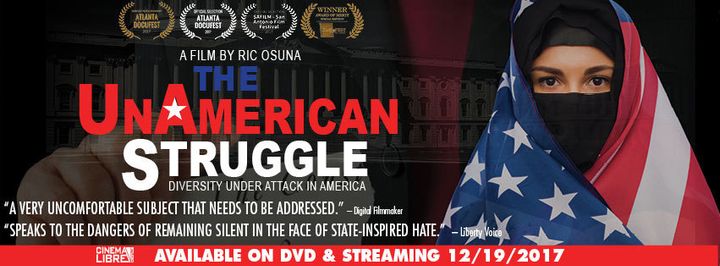
When Doug Jones won the Atlanta Senate seat on December 12, most Americans breathed a sigh of relief. They were able to point to the victory as a sign that the beating heart of American values was not yet dead, and that there was hope for the country’s future.
A new documentary film, “The UnAmerican Struggle,” written and directed by Ric Osuna, is a primer on how to revitalize the American quest to fulfill a vision of liberty and justice for all in the age of Trump.
Those concepts have often fallen quite short of the idealized notion Americans identify with — beginning with the decimation of the indigenous population inhabiting the land when Europeans first arrived.
Speaking to the camera, Osuna states his mission: “To examine the resurgence of bigotry that Trump brought about with his words.”
Osuna weaves darker pages from American history with the challenges the nation is currently facing. For those unaware of these narratives, they contextualize our current issues with lessons from the past.
Setting the tone with an image of the Statue of Liberty and the words of Emma Lazarus, Osuna presents the popular view of America as a haven to the oppressed and downtrodden.
How then, Osuna asks, did 62 million American voters cast their ballots for a candidate promoting a message of “racism, sexism, and xenophobia?”
Interviewing a group of experts to address this question, Osuna hopes to inform viewers by examining the specific challenges facing Hispanics, Muslims, African Americans, women, and the Transgender communities — as they struggle to achieve the promise of “Tolerance, Equality, and Diversity” in an “inclusive” America.
Throughout the film, Osuna features clips of Trump’s inflammatory rhetoric as he expounds upon his “Make American Great Again” vision. Osuna juxtaposes it with footage of previous presidents.
Trump riles up a crowd about “bad hombres” and “building a wall.” Obama states, “We can be a nation of laws and a nation of immigrants.” Ronald Reagan addresses Mikhail Gorbachev when he implores him to tear down the Berlin Wall. Post 9/11, George W. Bush makes a point of visiting a mosque and emphasizing, “The face of terror is not the true face of Islam. That’s not what Islam is all about.”
Trump, conversely, elevates the dog whistle to a high-pitched screech. He employs the term “traditional values” to appeal to hate groups and white nationalists. Using the cult of personality, like other strongmen, Trump mobilized the fear and dissatisfaction of a swath of Americans who felt threatened about their place in society.
Edward Ahmed Mitchell, Executive Director of the Council on American-Islamic Relations (CAIR) qualified Trump’s methodology: “He managed to marry a populist message with a message of hate.”
Professor of Sociology and Public Health at Georgia State University, Eric Wright, points to the Trump “charisma” to attract followers. Wright suggests that Trump “tapped into the reality that diversity is actually really difficult.” It takes work, especially when it is “easier” to be surrounded by people who share your exact same identity.
Osuna calls on his experts to deconstruct the “alt-right” terminology. Heidi Beirich, Director of the Intelligence Project at the Southern Poverty Law Center (SPLC), believes that the term alt-right is a branding move to position white supremacists as an entity sounding like it is on the political spectrum — rather than the white nationalists that they are. Angeles Valenciano, CEO of the National Diversity Council, believes the term normalizes white supremacy.
Using technology and the internet to connect with like-minded thinkers, the alt-right philosophy embodies the concept of “ethnic cleansing to achieve a white state.” Jeff Graham, Executive Director of Georgia Equality, expressed his fear of the Trump administration. “It should trouble everyone that the alt-right people saw something in Trump that galvanized them. They saw him as a kind of kindred spirit.”
The day after Trump’s win, life in America changed. Beirich states that at the SPLC office, “The phones were ringing off the hook.” She added, “There was a massive eruption by Trump supporters emboldened by the election.” Perhaps not totally surprised, Beirich noted that the United States has always been “deeply racist, deeply anti-Semitic.” Beirich observed, “We have a history of all that kind of bigotry. It’s part of our DNA.”
The concept of formally documenting and registering a subset of Americans, based on religion or ethnicity, is not new. Indeed, as the documentary points out, xenophobia was previously used before to “threaten or take away civil liberties of specific groups.”
Osuna presents previous examples. In 1917, during World War I, Woodrow Wilson ordered “registrations, internment, and eventual deportation of many German born residents.” Better know are the internment camps, built by Franklin Roosevelt, to house over 120,000 Japanese-American citizens during World War II.
The Associated Press reported that the Trump administration had discussed using the National Guard as a “deportation force.” They have threatened sanctuary cities determined to protect citizens, and have given Immigration and Customs Enforcement (ICE) officers latitude to use ruthless tactics.
Hate marches and gatherings are also not novel. Osuna illuminates two from the 20th century. The 1925 Klu Klux Klan march in Washington, D.C. attracted 30,000 participants. In 1939, the American Nazi Party held a huge rally in Madison Square Garden.
Breaking down the specific experiences of Hispanics, Muslims, African Americans, Women, and the Transgender community, Osuna gives viewers historical backstory combined with present-day stats. When discussing immigration, the film points out that 40 percent of undocumented immigrants are people who have overstayed their visas.
Dr. Rogelio Sáenz, Dean at the University of Texas, commented on the “influx of educated Latinos.” His family has been in America for three to four generations. Social worker Mayra Mendoza points to the fact that all Spanish speaking people get lumped together, whether they come from Central America, South America, or the Caribbean. Ironically, many have roots to America dating back from territories were part of Mexico.
There are 3 million Muslim Americans. A May 2017 report found that in 2016, there had been a 44 percent increase in acts of violence against them. The film underscores the specificity of threats to individuals, including a high school teacher who received a note suggesting she hang herself with her hijab.
When looking at the experiences of Black Americans, Osuna traces the transport of slaves to the United States from Africa — through segregation and the civil rights movement. He shows how the excessive policing of the African American community in the 1970s — under the guise of “the war on drugs” — laid the groundwork for using the justice system to implement structural racism. The United States has 25 percent of the world’s prison population, although we make up only 5 percent of the global population.
Women and the LGBTQ population are also under fire in Trumpland. Reproductive Health options are slipping away and the pay gap may not equalize until the middle of the 22nd century. The Supreme Court decision to legalize same-sex marriage has created a backlash and given rise to government officials who want to codify their religious beliefs into law.
The biggest takeaway from “UnAmerican Struggle” is the harm that the “complacency of silence” leads to. Trump has routinized intolerance and bigotry, and it is now up to individual Americans to reject it.
Beirich sums up succinctly: “People who stay silent in the face of Trump’s extremism are accepting it…They are sanctioning it. When you don’t make a fuss, it’s as though you agree. In this situation, silence is completely unacceptable.”
Community organizer Robert Salcido, Jr. works with the Equality Texas and Pride Center He believes that we can’t retreat. Rather, Salcido suggests that we all become teachers and “educate one person at a time.”
Osuna’s final thought is conclusive: “The America of tomorrow is being defined now.”

Watch the trailer.
Photos: Courtesy of UnAmerican Struggle
